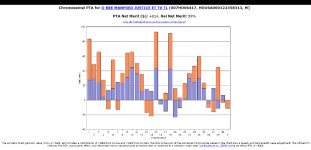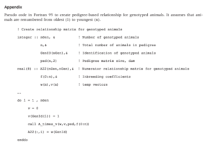librarian
Well-known member
Are these observations just the result of a reduction in alleles available for recombination or is there a possibility the male alleles are somehow evolving RESISTANCE to recombination?
Cattle Sex-Specific Recombination and Genetic Control from a Large Pedigree Analysis
Li Ma, Jeffrey R. O'Connell, Paul M. VanRaden, Botong Shen, Abinash Padhi, Chuanyu Sun, [...view 5 more...], George R. Wiggans
http://journals.plos.org/plosgenetics/article?id=10.1371/journal.pgen.1005387
From the discussion...
Although the biological significance for a longer male map in contrast to most mammalian species is unclear, we speculate that cattle domestication, which was estimated to have begun approximately 10,000 to 11,000 years ago [54], and the intense artificial selection targeting specific traits thereafter, could be a plausible explanation. In the past, the breeding practices in dairy cattle have put more selection pressure on bulls than on cows. Based on several theories of recombination rate evolution, this male-biased selection may lead to a higher recombination rate in bulls if selection has a direct or indirect, positive effect on recombination [55–57]. Such a pattern of a longer male map was also observed in sheep [58], which is presumed to have been domesticated during the same contemporary period as dairy was domesticated and then underwent similar male-biased selective breeding [59]. In contrast to domestic sheep, the female recombination rate of the wild bighorn sheep was reported to be 12% greater than that of the male [60].
We found a significantly decreasing trend in recombination rate in males from the analyses of recombination in the past forty years. Such decline in recombination rate in the past forty years coincided with the steady increase in milk production and decrease in fertility, a result of the intensive artificial selection in cattle breeding [47,63,64]. Although recombination generally increases selection efficiency by providing more combinations of genetic alleles [3], recombination likely was selected against in cattle breeding that predominantly occurred in males. In cattle breeding, bulls tended to carry more desired chromosomes so that a male progeny that inherited the most chromosome segments from an elite sire would have better performance and more chance to be selected for breeding. In other words, the cattle breeding favored paternal haplotypes that were not or less mixed with the maternal haplotypes during meiosis. Therefore, a sex-biased cattle breeding and selection could potentially decrease the number of recombination in a short period and likely explain the reduction of recombination rate in cattle, particularly in males. To evaluate whether the decrease in recombination rate is correlated with systematic changes in allele frequencies of associated genetic variants, we calculated the frequencies of the alleles that increase recombination rate for associated SNPs over years but found no clear patterns (S11 Fig). Inbreeding decreases the power of identifying crossovers through reducing the number of heterozygote SNPs per individual, so we adjusted for the effect of inbreeding by including the genomic inbreeding coefficient of the individual and the numbers of informative (phased heterozygote) SNPs in both the parent and offspring in a linear model. As expected, we found a negative association between inbreeding coefficient and number of recombination events in both sexes.
Cattle Sex-Specific Recombination and Genetic Control from a Large Pedigree Analysis
Li Ma, Jeffrey R. O'Connell, Paul M. VanRaden, Botong Shen, Abinash Padhi, Chuanyu Sun, [...view 5 more...], George R. Wiggans
http://journals.plos.org/plosgenetics/article?id=10.1371/journal.pgen.1005387
From the discussion...
Although the biological significance for a longer male map in contrast to most mammalian species is unclear, we speculate that cattle domestication, which was estimated to have begun approximately 10,000 to 11,000 years ago [54], and the intense artificial selection targeting specific traits thereafter, could be a plausible explanation. In the past, the breeding practices in dairy cattle have put more selection pressure on bulls than on cows. Based on several theories of recombination rate evolution, this male-biased selection may lead to a higher recombination rate in bulls if selection has a direct or indirect, positive effect on recombination [55–57]. Such a pattern of a longer male map was also observed in sheep [58], which is presumed to have been domesticated during the same contemporary period as dairy was domesticated and then underwent similar male-biased selective breeding [59]. In contrast to domestic sheep, the female recombination rate of the wild bighorn sheep was reported to be 12% greater than that of the male [60].
We found a significantly decreasing trend in recombination rate in males from the analyses of recombination in the past forty years. Such decline in recombination rate in the past forty years coincided with the steady increase in milk production and decrease in fertility, a result of the intensive artificial selection in cattle breeding [47,63,64]. Although recombination generally increases selection efficiency by providing more combinations of genetic alleles [3], recombination likely was selected against in cattle breeding that predominantly occurred in males. In cattle breeding, bulls tended to carry more desired chromosomes so that a male progeny that inherited the most chromosome segments from an elite sire would have better performance and more chance to be selected for breeding. In other words, the cattle breeding favored paternal haplotypes that were not or less mixed with the maternal haplotypes during meiosis. Therefore, a sex-biased cattle breeding and selection could potentially decrease the number of recombination in a short period and likely explain the reduction of recombination rate in cattle, particularly in males. To evaluate whether the decrease in recombination rate is correlated with systematic changes in allele frequencies of associated genetic variants, we calculated the frequencies of the alleles that increase recombination rate for associated SNPs over years but found no clear patterns (S11 Fig). Inbreeding decreases the power of identifying crossovers through reducing the number of heterozygote SNPs per individual, so we adjusted for the effect of inbreeding by including the genomic inbreeding coefficient of the individual and the numbers of informative (phased heterozygote) SNPs in both the parent and offspring in a linear model. As expected, we found a negative association between inbreeding coefficient and number of recombination events in both sexes.



